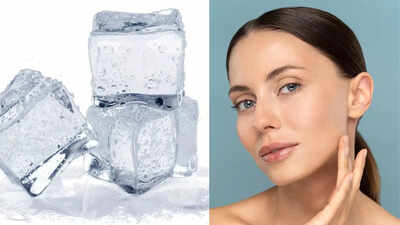Facial icing, or cryotherapy, has surged in popularity on social media, touted for its potential therapeutic and aesthetic benefits. Proponents claim it can alleviate acne, reduce swollen eyes, and address various other skin concerns. However, while cold therapy is a recognized treatment for injuries and pain management, the scientific community remains skeptical about its benefits specifically for facial skin.

Despite the lack of conclusive scientific evidence, many individuals believe in the efficacy of facial icing. This belief has fueled its rise as a popular beauty trend. Further research is necessary to definitively validate its purported benefits for the skin.
For those interested in trying this trend, Healthline suggests two common methods for applying ice to the face:
With either method, gently massage your face in slow, circular motions for approximately 1 to 2 minutes. Exercise caution to avoid prolonged direct contact between the ice and your skin, as extended exposure can lead to irritation.
This circular massage can be performed once daily, focusing on areas such as:
Before incorporating ice facials into your routine, seek personalized guidance from a healthcare or skincare professional. Here are some helpful tips to keep in mind:
It is also important to change the ice and wrapping frequently to prevent the spread of bacteria, and to see icing as a supplemental element, not a replacement, to your existing skincare regimen.
Several factors contribute to the rising popularity of ice facials:
According to Healthline, prolonged or improper facial icing can result in:
Furthermore, individuals with pre-existing health conditions, such as diabetes or Raynaud's syndrome, should exercise caution or consult a doctor before trying facial icing, as it may exacerbate existing sensitivities or nerve-related issues.
Facial icing offers several potential benefits, including:
While these benefits appear promising, more research is warranted to confirm the direct impact of facial icing on puffiness and acne.
Disclaimer: This content is intended for general informational purposes only and does not constitute medical or dermatological advice. Individual skin types and conditions may vary. It is crucial to consult with a qualified dermatologist before initiating any new skincare routines.
 New Zealand Cricket Announces Packed 2025-26 Home Summer Against Cricket Giants
New Zealand Cricket Announces Packed 2025-26 Home Summer Against Cricket Giants
 Cricketer Nitish Rana Eyes Delhi Comeback After Disappointing Uttar Pradesh Stint
Cricketer Nitish Rana Eyes Delhi Comeback After Disappointing Uttar Pradesh Stint
 SA20 Auction: Teams Can Keep Up to Six Players, Purse Increased to $2.3M
SA20 Auction: Teams Can Keep Up to Six Players, Purse Increased to $2.3M
 Facial Icing: Hype or Help? Exploring the Benefits, Risks, and Proper Techniques for This Viral Beauty Trend
Facial Icing: Hype or Help? Exploring the Benefits, Risks, and Proper Techniques for This Viral Beauty Trend
 Smith Targets Test Return After Baseball Cage Rehab
Smith Targets Test Return After Baseball Cage Rehab


